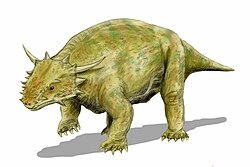| Theledectinae Temporal range: Early-Middle Triassic, | |
|---|---|
 | |
| Holotype of Eomurruna | |
| Scientific classification | |
| Domain: | Eukaryota |
| Kingdom: | Animalia |
| Phylum: | Chordata |
| Clade: | † Parareptilia |
| Order: | † Procolophonomorpha |
| Family: | † Procolophonidae |
| Subfamily: | † Theledectinae Cisneros, 2008 |
| Genera | |
| |
Theledectinae is an extinct subfamily of parareptiles within the family Procolophonidae. Theledectines existed in South Africa, China and Australia during the Early-Middle Triassic period (Induan to Anisian stages). Theledectinae was named by Juan Carlos Cisneros in 2008 to include the genus Theledectes , and the species "Eumetabolodon" dongshengensis . "E." dongshengensis represents a new genus from China. Cladistically, it is defined as "All taxa more closely related to Theledectes perforatus (Gow, 1977a) than to Procolophon trigoniceps Owen, 1876". [1] In 2020, Hamley add the new genus Eomurruna from Australia to this subfamily. [2]

